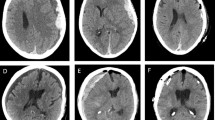Abstract
Introduction
There are limited data with regards to the associated risk of post-operative seizures in patients with surgically treated chronic subdural hematomas (CSDHs). The use of anti-epileptic drugs (AEDs) is associated with significant side effects.
Methods
A retrospective chart review was performed on patients operated via burr hole for CSDH in our institution from 2004 to 2013. Post-operative seizures at 1-year follow-up were identified. Demographic data, medical history, and imaging characteristics were recorded.
Results
A total of 220 patients were included in the study. Post-operative seizures occurred in 2.3%. The mean time of onset of seizures was 8.4 days. No difference in age and gender between seizing and non-seizing groups was identified p > 0.05. Mean midline shift was 4.6 mm in seizing group vs. 4.2 mm in non-seizing group, p > 0.05. Mean thickness was 14.6 mm in patients without post-operative seizures and 18.4 mm in patients with post-operative seizures, p > 0.05. There was no significant difference in post-operative seizure incidence related to the side or location of the CSDHs.
Conclusions
The incidence of post-operative seizures in patients with CSDH evacuated via burr holes was low. Prophylactic AEDs should not be routinely administered if no other risk factor for seizure exists. Demographic and clinical factors did not appear to influence post-operative seizures.
Similar content being viewed by others
References
Chang EF, Potts MB, Keles GE, Lamborn KR, Chang SM, Barbaro NM et al (2008) Seizure characteristics and control following resection in 332 patients with low-grade gliomas. J Neurosurg 108(2):227–235
Chari A, Kolias AG, Santarius T, Bond S, Hutchinson PJ (2014) Twist-drill craniostomy with hollow screws for evacuation of chronic subdural hematoma. J Neurosurg 121(1):176–183
Christensen J (2012) Traumatic brain injury: risks of epilepsy and implications for medicolegal assessment. Epilepsia 53(Suppl. 4):43–47
Glantz MJ, Cole BF, Friedberg MH, Lathi E, Choy H, Furie K et al (1996) A randomized, blinded, placebo-controlled trial of divalproex sodium prophylaxis in adults with newly diagnosed brain tumors. Neurology 46(4):985–991
Grisoli F, Graziani N, Peragut JC, Vincentelli F, Fabrizi AP, Caruso G et al (1988) Perioperative lumbar injection of Ringer’s lactate solution in chronic subdural hematomas: a series of 100 cases. Neurosurgery 23:616–621
Grobelny BT, Ducruet AF, Zacharia BE, Hickman ZL, Andersen KN, Sussman E et al (2009) Preoperative antiepileptic drug administration and the incidence of postoperative seizures following bur hole-treated chronic subdural hematoma. J Neurosurg 11(6):1257–1262
Hirakawa K, Hashizume K, Fuchinoue T, Takahashi H, No-mura K (1972) Statistical analysis of chronic subdural hematoma in 309 adult cases. Neurol Med Chir (Tokyo) 12:71–83
Karibe H, Kameyama M, Kawase M, Hirano T, Kawaguchi T, Tominaga T (2011) Epidemiology of chronic subdural hematomas. No Shinkei Geka 39(12):1149–1153
Kudo H, Kuwamura K, Izawa I, Sawa H, Tamaki N (1992) Chronic subdural hematoma in elderly people: present status on Awaji Island and epidemiological prospect. Neurol Med Chir (Tokyo) 32:207–209
Mori K, Maeda M (2001) Surgical treatment of chronic subdural hematoma in 500 consecutive cases: clinical characteristics, surgical outcome, complications, and recurrence rate. Neurol Med Chir (Tokyo) 41:371–381
Sabo RA, Hanigan WC, Aldag JC (1995) Chronic subdural hematomas and seizures: the role of prophylactic anticonvulsive medication. Surg Neurol 43:579–582
Schneck MJ, Maheswaran M, Leurgans S (2004) Predictors of outcomes after nontraumatic subdural hematoma. J Stroke Cerebrovasc Dis 13:192–195
Singh AK, Suryanarayanan B, Choudhary A, Prasad A, Singh S, Gupta LN (2014) A prospective randomized study of use of drain versus no drain after burr-hole evacuation of chronic subdural hematoma. Neurol India 62(2):169–174
Temkin NR, Anderson GD, Winn HR, Ellenbogen RG, Britz GW, Schuster J et al (2007) Magnesium sulfate for neuroprotection after traumatic brain injury: a randomised controlled trial. Lancet Neurol 6(1):29–38
Temkin NR, Dikmen SS, Wilensky AJ, Keihm J, Chabal S, Winn HR (1990) A randomized, double-blind study of phenytoin for the prevention of post-traumatic seizures. N Engl J Med 323(8):497–502
Van Breemen MSM, Wilms EB, Vecht CJ (2007) Epilepsy in patients with brain tumours: epidemiology, mechanisms, and management. Lancet Neurol 6:421–430
Wang HC, Chang WN, Chang HW, Ho JT, Yang TM, Lin WC et al (2008) Factors predictive of outcome in posttraumatic seizures. J Trauma 64:883–888
Funding
No funding was received for this research.
Author information
Authors and Affiliations
Corresponding author
Ethics declarations
Conflict of interest
All authors certify that they have no affiliations
with or involvement in any organization or entity with any financial interest (such as honoraria; educational grants; participation in speakers’ bureaus; membership, employment, consultancies, stock ownership, or other equity interest; and expert testimony or patent-licensing arrangements), or non-financial interest (such as personal or professional relationships, affiliations, knowledge or beliefs) in the subject matter or materials discussed in this manuscript.
Ethical approval
All procedures performed in studies involving human
participants were in accordance with the ethical standards of the institutional and/or national research committee and with the 1964 Helsinki Declaration and its later amendments or comparable ethical standards. For this type of study formal consent is not required
Rights and permissions
About this article
Cite this article
Flores, G., Vicenty, J.C. & Pastrana, E.A. Post-operative seizures after burr hole evacuation of chronic subdural hematomas: is prophylactic anti-epileptic medication needed?. Acta Neurochir 159, 2033–2036 (2017). https://doi.org/10.1007/s00701-017-3298-6
Received:
Accepted:
Published:
Issue Date:
DOI: https://doi.org/10.1007/s00701-017-3298-6




